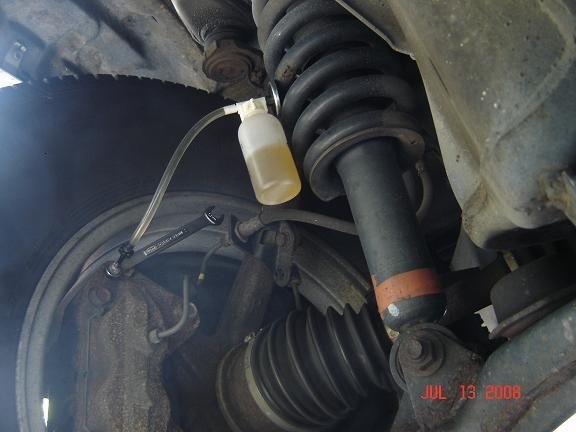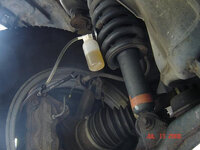
Apologies for the delay, I haven't had the time to retake the photos so I'll be using some older photos that don't belong to me as reference. In this final chapter of 'improving brake performance', we'll talk about brake bleeding, brake pad embedding/running in and types of brake oils.
Brake pad embedding
Most manufacturers manufacture their brake pads with an outer later that require wearing off before the actual performance of the brake can be realised. There's a good reason for this -
Most brake pad manufacturers use metallic substances in their formula and metal is prone to oxidation and corrosion. Brake pads have to be able to stay in the store for weeks/months without losing their braking properties. Hence the advice from mechanics to "take it easy" right after new pads are installed, mainly because the brake pads won't perform at their peak until the protective layer is worn off.
Having said that however, there are brake pads out there that don't require running in such as the EBC Ultimax performance pads. You can plonk these babies in and go jam your brakes without worrying about brake pad failure. But for the rest, take it easy and run in the pads according to the manufacturer specs.
The Ferodo Zero manual states to drive for 200m while lightly depressing the brakes and not to travel more than 80km/h. This process is to continue on for about 2km before the brake pads are really worn in.
The Bosch pads similarly require a slow and steady run in process before they bite. Some brands however work best right after you smoke them! So basically just refer to the manufacturers recommendation before you go all out with the new pads.
The other reason why you'd want to embed the pads is because the surface contact area on the brake rotor and the pad is not in synch yet. The rotor is not completely flat probably because of wear from the previous pads or skimming. The pads weren't manufactured with 99% tolerance so they probably aren't completely flat too. Ideally you'd want to get the brake pads to sit flatly on the rotor so you get maximum surface area contact between the pad and rotor for optimum braking efficiency.
Again, this process is a take-it-easy process. Don't rush it and let the pads mould itself into the shape of the rotor. This embedding usually takes about a week of slow driving and gradual braking. It helps if your rotor is slotted as that'll skim the brake pads surface faster.
Basically moral of the story is : Once the new pads are in, take it easy.
Important Note : Once you've replaced your pads or taken out the pads for whatever reason, always remember to pump your brakes a bit after you start your car. You need to get that firm brake pedal feel before you shift your car in gear!
Brake bleeding
Why do you need to bleed your brakes? Whenever you stamp on your brake pedals, it triggers a hydraulic pump that will force brake fluid into your calipers to clamp onto the brake pads. If there is air in the system, the pump will need to compress the air as well which will result in the spongy feel in your pedal. So we'd want to get rid of all that air where possible, hence brake bleeding.
http://farm7.static.flickr.com/6214/6216006917_fb92ded30e_z.jpg
First identify the bleed nipple (shown in the picture above). Note that these bleed nipples are very soft so do not use brute force to tighten or loosen it. You'll run the chance of ruining the thread.
You'll need :
1. 2 people to work this
2. Jack and jackstand
3. Aquarium air tubes and a bottle
4. Closed end spanner to open and close the bleed nipple
5. New brake oil for topping up.
http://farm7.static.flickr.com/6100/6216514212_6633a566aa_z.jpg
Use a close ended spanner and fit it around the bleed nipple and connect the hose to the nipple mouth. Open the brake reservoir and start your car. Have a friend pump the brakes (while sitting in the car) for about 5 to 6 times and keep the foot depressed on the pedal. Note - do not use brute force to press! Use normal pressure to press the pedal. Then open the bleed nipple to release the brake fluid and pressure, then tighten it again. Pump, release, tighten, pump, release, tighten, etc until the fluid that's coming out is bubble free - you should be able to see this in the tube. If you're flushing your brake oil, repeat the pump, release, tighten process until the fluid that comes out is clear and not discoloured.
Remember to keep topping up your brake fluid at the reservoir. Don't let it dry up otherwise you'll introduce air in and that defeats the purpose of the brake bleed.
Repeat all 4 wheels and you can keep doing this until you're satisfied that there are no more air bubbles or until your brake fluid is clear and clean. Tighten the bleed nipples (but not overly tight! You should be able to feel how tight it needs to be). Reinstall your rims and you're done!
Types of brake fluids
http://farm7.static.flickr.com/6152/6216078803_7df3f21b95_z.jpg
I've been reading a lot of chatter about the type of DOT oil you can use in your car. As a general rule I advise folks to stick back to the manufacturers guidelines. If it says to use DOT3, then stick with DOT3. DOT5 then use only DOT5. But for the more adventurous few and for those who have the know-how, you can use other types of brake oils in your car for better performance.
Generally nowadays in the market there are 4 types of brake oils : DOT3, DOT4, DOT5 and DOT5.1
The only brake oil you need be cautious about is DOT5 since that is the only silicone based oil and is not compatible with the other 3. The other 3 are glycol based so use whichever type of oil your car manufacturer advises! (Silicone based or Glycol based).
DOT3, 4 and 5.1 are backward compatible. But if your car specifies DOT5.1, use only 5.1. If it says to use DOT4, then use only DOT4 or 5.1. If it says DOT3, then any of the 3 is fine.
If it says DOT5, use only DOT5.
I personally use DOT5.1 for all my cars even though the manual recommends only DOT3/4. Why do I use 5.1? Because of the boiling point. DOT5.1 has the highest boiling point amongst all the brake oils. Why is this important? If you exceed the boiling point for the oil (which happens when you agressively use the brakes) it vaporizes and that's bad in terms of transferring the hydraulic pressure to the calipers.
(Taken off Wikipedia)
http://farm7.static.flickr.com/6051/6216170227_fa8a7b284b.jpg
Wet boiling point defined as 3.7% water by volume. (In this case water means the fluid is contaminated and probably should be changed.)
So when choosing your brake fluids, choose wisely.
Happy DIY-ing!


